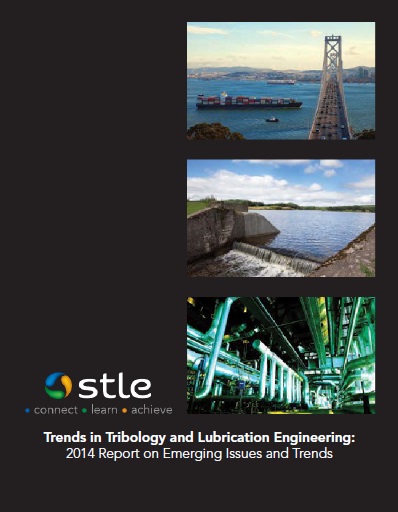Are you thinking small?
Edward P. Salek, CAE, Executive Director | TLT Headquarters Report October 2014
STLE’s 2014 report on emerging trends reveals the challenges and opportunities of atomistic processes.

STLE’s 2014 Report on Emerging Trends and Issues examines the importance of tribology and lubrication engineering in science and production.
WHENEVER I ATTEND CONFERENCES OR VISIT COMPANIES on STLE’s behalf, one question always gets asked: What trends or developments are causing people in your field to be excited about the future?
Answers to this persistent question can be found in STLE’s 2014
Report on Emerging Issues and Trends. This new report is the culmination of a multiphase research effort to evaluate current trends and to predict future developments impacting the field. The research encompasses the global opinions and experiences of nearly 1,000 tribologists and lubrication engineers who participated in the project as advisors, interview and focus group participants, and survey respondents.
Emerging Issues and Trends seeks to emphasize the importance of tribology and lubrication engineering in science and production. The report makes that connection clearer, both for the public as well as for those who work with professionals in the field. It also illustrates the unique scientific and engineering dilemmas that tribologists and lubrication engineers face in their field of work. It is divided into nine major areas:
1.
The outlook on the field
2.
Energy
3.
Manufacturing
4.
Transportation
5.
Atomistic processes
6.
Other tribology topics
7.
Government regulation
8.
Safety and the environment
9.
Basic human needs.
Developments in one of these nine areas, atomistic processes or friction and wear at the molecular level, became topic No. 1 during a recent visit to the STLE headquarters office by a team of representatives from an STLE Corporate Member company. As it turned out, atomistic processes are the focus of an emerging aspect of this company’s research and development program.
Although we did not get into specifics of their particular case, the STLE study did shed light on why this topic is becoming recognized as an area with large untapped potential and substantial long-term impact. Approximately two-thirds of the respondents (65 percent) cited the linking of atomic-scale behavior with larger-level systems behavior as a top long-term (10-plus years) trend.
According to the report, “Tribology and lubrication in itself may be simple, but there are so many underlying principles that we do not understand, or only partially understand, that it will be more and more important to solve the science.” Doing so could lead to application-specific advantages such as the ability to understand why a particular molecule is a superior lubricant additive, the report notes.
Recognizing the interest in this area of study, STLE is putting an immediate emphasis on nanotechnology and nanotribology issues at this month’s new Tribology Frontiers Conference (TFC), Oct. 26-28 in Chicago. More than 40 presentations dealing with atomistic processes are among the 200 technical presentations distributed across seven tracks. The TFC builds on STLE’s tradition of fall conference excellence with a dynamic new format that highlights the role tribology research will play in solving future scientific and societal challenges.
Both the TFC and the Emerging Trends report have been designed as ongoing projects to support STLE strategic goals related to global advocacy and innovation in tribology and lubrication engineering. Portions of the Emerging Trends report will be serialized in future issues of TLT. STLE members can download a free digital copy of the full report through the STLE Website (
www.stle.org).
 You can reach Certified Association Executive Ed Salek at esalek@stle.org
You can reach Certified Association Executive Ed Salek at esalek@stle.org.